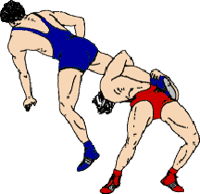The level 10 gymnast with the World Class team was enjoying another successful season, with a state all-around title and regional crowns in the vault and floor exercises under her belt. A scholarship offer from a large Division I school in the SEC was on the table. Heading into May and one week before Junior Nationals, Lambert looked to have the world on a string.
In an instant, she almost lost it all.
 |
| Ashley Lambert's gymnastics career almost ended abruptly last year when she suffered a broken neck. Amazingly, she's back in the sport. |
Amazingly, the Menchville junior was not aware of
the seriousness of her condition and continued to practice. Mother Tonia came
to pick her up, and as she recalls found her daughter “doing crunches and
crying.” However, Ashley did not want to make World Class coaches Tami Harrison or
Jon Angle aware of her pain. Later, at home, Tonia recalls spending 15 minutes
trying to pop Ashley’s neck, thinking it was simply jammed. Looking back she
now realizes, “I could have killed my child and didn’t even know it at the
time.” But as soon as Ashley complained that her left eye had gone numb, the
mother quickly knew what had occurred.
Says Tonia, “Right then, I knew it was neuro
(related).” Four hours after leaving practice, the pair headed to the hospital
emergency room.
After several hours in the waiting room, Tonia was
approached by the doctor.
“He came to me and said, I have some good news and
bad news. Which do you want to hear first?” Of course, she wanted to hear the
good news first.
He said, “it is by the sheer grace of God that your
kid is walking and talking. She only survived because of her sheer physical
condition and her youth.”
Ashley recalls her time in the ER.
“They did an X-ray and didn’t really find anything
specific. But when they looked at the results of the CAT scan, the doctors
started freaking out.” She was quickly transported to Portsmouth Naval Hospital
and fitted for a halo by the next morning.
For Lambert, the dream looked to be over. Gymnastics
appeared to be a sport of the past, replaced by the halo to stabilize her neck
and a lifetime of shattered dreams. Letters and get well wishes poured in from
fellow gymnasts in every corner of the country. It was assumed that just
getting Ashley back to normal activities would be the new goal.
But Ashley had larger aspirations. She missed not
seeing her World Class teammates and friends at Menchville as she completed the
school year with the homebound program. But after spending two-thirds of her 17
years in competitive gymnastics, Lambert was not ready to call it quits.
Recalls Tonia, “we had a conversation about it and
she said, what else am I supposed to do?
I have been doing this my whole life.”
After almost two months in a halo, Ashley placed a
video on her website, thanking her well-wishers. The most amazing feature of
the 19-second clip was the bright smile displayed. The next day, the halo was
removed.
Was there ever a concern about not competing again?
“Uh-huh.” The
biggest concern was that with junior year approaching, it was time to get back
to the gym and make sure that she earned her athletic scholarship, her goal
since beginning the sport at the age of six. The junior year of high school is
usually the most crucial, particularly in gymnastics, as most of the
scholarships for her class are awarded by the end of 11th grade.
So it was time to go back to work.
After six grueling months of training, averaging 30
hours a week in the gym, the young lady who escaped a life-threatening injury
returned to competition in January. In only her second competition, Lambert
placed second in two events and qualified for the level 10 regional meet, which
will be held on April 21-22 in Allentown, PA. But the larger goal is to qualify
for Junior Nationals, which will be held from May 10-13 in Hampton, VA. At this
point, Ashley feels as though she is “just getting back to where I was last
year.”
Is there anything to be learned from this
experience? In a closing thought, Tonia notes her daughter’s new found
appreciation for gymnastics, one which can only be gained by almost losing the
ability to continue at it.
“I think that she finds herself working much harder
now. For a long time, a lot of this was very easy for her.”
For more information about Ashley Lambert, visit her
website at http://www.gym-style.com/ashley











